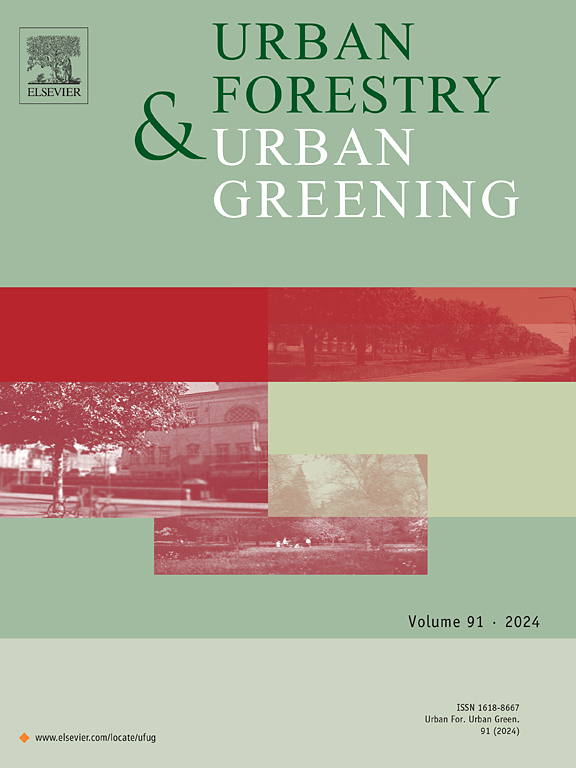Park thermal comfort and cooling mechanisms in present and future climate scenarios
IF 6
2区 环境科学与生态学
Q1 ENVIRONMENTAL STUDIES
引用次数: 0
Abstract
Extreme heat is Australia’s most perilous natural hazard, and increasing urban temperatures due to climate change are a growing concern. Consequently, there is growing interest in developing nature-based solutions (i.e., greenery and vegetated surfaces) to cool urban areas. Appropriately designed urban parks are anticipated to be crucial for maintaining thermal comfort as temperatures rise. The two main diurnal cooling mechanisms of urban parks are shade provision and vegetation transpiration. However, limited studies have examined the cooling performance of vegetation through transpiration, especially in the southern hemisphere. This study addresses this gap by examining the microclimatic conditions, cooling benefits, and thermal performance of a typical neighbourhood park in Perth, Western Australia, with a focus on the cooling performance of vegetation through shade and transpiration. Present and future microclimates were modelled and simulated for average and hottest summer days based on 25 years of local weather data and projections for 2090 under the Representative Concentration Pathway (RCP) 8.5 scenario. The findings reveal that trees provided diurnal cooling benefits for park users by lowering the Universal Thermal Comfort Index (UTCI) by up to 17°C, with this benefit persisting in projected 2090 conditions. This cooling benefit was predominantly achieved through shade provision, with marginal contributions from transpiration. Additionally, on hot days, as leaf temperature exceeded 30°C, increased stomatal resistance led to reduced transpiration. Therefore, more attention must be paid to transpiration cooling limits due to stomatal closure during hot hours to improve cooling performance in park design. Moreover, comparing different plant species’ behaviour and adaptability on hot days is crucial, especially in future climatic conditions.
当前和未来气候情景下的公园热舒适和冷却机制
极端高温是澳大利亚最危险的自然灾害,而气候变化导致的城市气温升高正日益引起人们的关注。因此,人们越来越关注开发基于自然的解决方案(即绿色植物和植被表面)来为城市地区降温。随着气温的升高,设计适当的城市公园预计将成为保持热舒适度的关键。城市公园的两大昼夜降温机制是遮荫和植被蒸腾。然而,通过蒸腾作用研究植被降温性能的研究非常有限,尤其是在南半球。本研究针对这一空白,对西澳大利亚珀斯一个典型街区公园的微气候条件、降温效益和热性能进行了研究,重点关注植被通过遮荫和蒸腾作用实现降温的性能。根据 25 年的当地天气数据和 2090 年代表性浓度途径 (RCP) 8.5 情景预测,对当前和未来的微气候进行了建模和模拟,以确定平均和最热的夏季天数。研究结果表明,树木为公园使用者提供了昼间降温效益,将通用热舒适指数(UTCI)降低了 17°C,而且这种效益在 2090 年的预测条件下仍将持续。这种降温效益主要是通过遮荫实现的,蒸腾作用的贡献微乎其微。此外,在高温天,当叶片温度超过 30°C 时,气孔阻力的增加会导致蒸腾作用的降低。因此,在公园设计中,必须更加关注高温时段气孔关闭导致的蒸腾冷却极限,以提高冷却性能。此外,比较不同植物物种在高温天的行为和适应性至关重要,尤其是在未来的气候条件下。
本文章由计算机程序翻译,如有差异,请以英文原文为准。
求助全文
约1分钟内获得全文
求助全文
来源期刊

Urban Forestry & Urban Greening
FORESTRY-
CiteScore
11.70
自引率
12.50%
发文量
289
审稿时长
70 days
期刊介绍:
Urban Forestry and Urban Greening is a refereed, international journal aimed at presenting high-quality research with urban and peri-urban woody and non-woody vegetation and its use, planning, design, establishment and management as its main topics. Urban Forestry and Urban Greening concentrates on all tree-dominated (as joint together in the urban forest) as well as other green resources in and around urban areas, such as woodlands, public and private urban parks and gardens, urban nature areas, street tree and square plantations, botanical gardens and cemeteries.
The journal welcomes basic and applied research papers, as well as review papers and short communications. Contributions should focus on one or more of the following aspects:
-Form and functions of urban forests and other vegetation, including aspects of urban ecology.
-Policy-making, planning and design related to urban forests and other vegetation.
-Selection and establishment of tree resources and other vegetation for urban environments.
-Management of urban forests and other vegetation.
Original contributions of a high academic standard are invited from a wide range of disciplines and fields, including forestry, biology, horticulture, arboriculture, landscape ecology, pathology, soil science, hydrology, landscape architecture, landscape planning, urban planning and design, economics, sociology, environmental psychology, public health, and education.
 求助内容:
求助内容: 应助结果提醒方式:
应助结果提醒方式:


